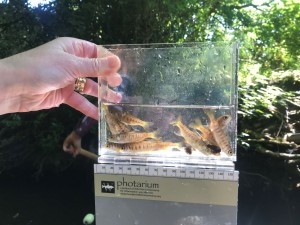— Peter Guillozet, Orcas Island Preserve Steward
On an idyllic morning in late July, local consultant Jenny De Groot, volunteer Jerry Weatherman, and Land Bank staff Kayla Seaforth and Peter Guillozet completed an annual fish survey in the lower section of Orcas Island’s Cascade Creek. The creek tumbles roughly two and a half miles down the mountain from its headwaters near Mountain Lake in Moran State Park to Buck Bay near Olga. Its winds through canyons and over falls shaded by mixed coniferous forests to the Land Bank’s 24-acre Coho Preserve. Acquired with the help of partners in 2016, the preserve protects the lower portion of the creek, which is one of the few remaining salmon spawning areas in San Juan County. Because natural waterfalls limit migration by salmonid to the lower 200 yards of the creek, the habitat within Coho Preserve is essential for both Coho salmon and Coastal cutthroat trout.
Over the years, Washington agencies including the Department of Ecology, State Parks and the Department of Fish and Wildlife have studied both fish populations and flow in Cascade Creek. While there is uncertainty about pre-disturbance fish populations and the genetic origins of the current fish, observations of Coho salmon in Cascade Creek dating to the 1950s suggest that this may be the only wild salmon run in the San Juan Islands. Although Coastal cutthroat trout tend to receive less attention than salmon, they’re also an important and resilient component of the ecology of our island streams.
The Land Bank has been monitoring Cascade Creek since 2016. Over this time, native fish populations have faced chronically low stream flow during certain times of the year as well as unintentional de-watering of the stream as a result of water withdrawals for hydropower and domestic use. Because Coho salmon and sea-run coastal cutthroat trout spend at least one full year in freshwater before entering saltwater they are particularly vulnerable in streams with seasonally low flows.
Last November we observed two female Coho salmon attempting to spawn in the creek. Although we were concerned about low flows at the time, preliminary sampling this April revealed over 200 of their offspring. This July, using a pole sein and working upstream from the mouth to the falls, we sampled twelve transects. As usual, we transferred captured fish into buckets filled with fresh water and then identified and measured each individual before releasing them at their original locations. In all, we counted 177 Coho salmon (Oncorhynchus kisutch) averaging about 6.5 centimeters in length. We also counted 11 Coastal cutthroat trout (Oncorhynchus clarki clarki) averaging 14.1 centimeters, 123 sculpins averaging 7.4 centimeters, five non-native Brook trout averaging 13.7 centimeters, one shiner perch and one crayfish.![]()
Although recent Coho and other salmon returns are low throughout the state, this year’s cohort in Cascade Creek along with the small but healthy Coastal cutthroat trout population should fill us all with hope for the future. In order to thrive, native fish need little more than enough clean, cool water protected by an intact riparian corridor to complete their life cycles. Fortunately, recent discussions with water rights owners point towards increasing collaboration to ensure adequate stream flow for fish.


